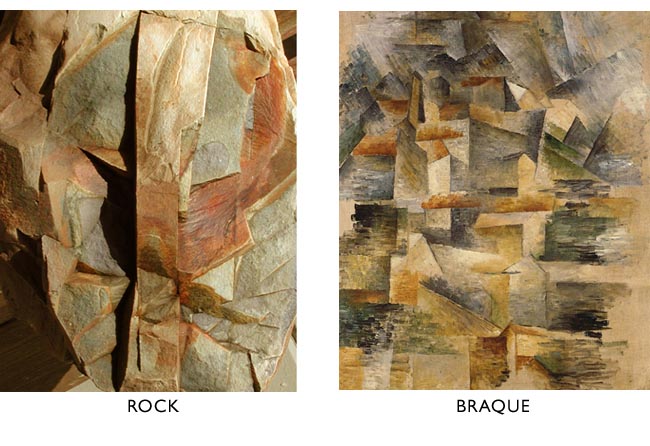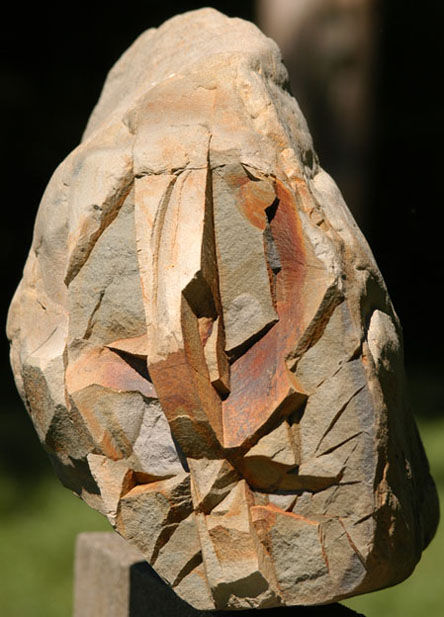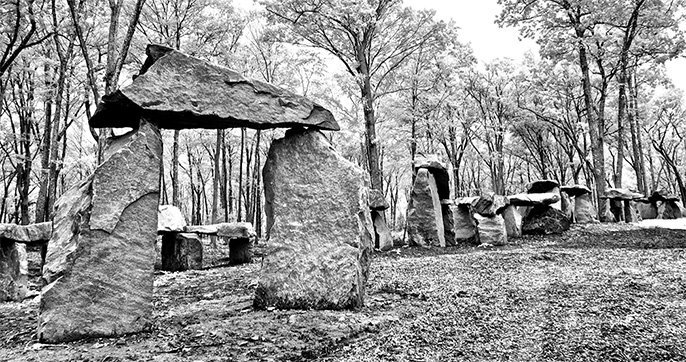Glacial erratics: landscape found art (and origins of cubism)
March 15, 2004 | Edward Tufte
32 Comment(s)
Helping to build a road today, I threw a rock (about 0.4 cubic feet in volume) into the road bed. The end of the rock shattered and revealed the ultimate source of Cubism. “Fractured planes” is a good short description of Cubism.
Today’s fractured rock is on the left; Braque’s Rio Tinto Factories at L’Estaque, 1910, at right.




Topics: 3-Star Threads, E.T.




Here’s my piece of cubist stone landscape art, Cubist Bear, 2003, made from edited and modified stones we dug up with backhoes while clearing a field. The largest stone is about 7 feet high and really heavy (maybe 10 to 14 tons).
Vocabulary needed, please.
What is the name of the ability to make a connection between the rock and the
Braque? It seems to be a trait shared by gifted teachers and other observers
who can form illuminating connections. I have considered “aggregator” or
“synthesizer,” both of which hint, but neither of which is accurate. It ‘s a faculty
to make an analogy, but has more to do with connections and relationships
and references than “like” or “as”. Ideas?
Just the good luck to see the rock. Even the Braque Rock colors were right on.
“Cubist Bear” above is probably a “glacial erratic,” a rock carried a distance from its origin by a glacier and then deposited when the glacier melts. See http://pubs.usgs.gov/of/2004/1216/e/e.html Note the rounded and smoothed surface of Cubist Bear, a rock which distinctly differs from red sandstone ledge, the characteristic rock around here. The Braque Rock above, much smaller, also resembles a glacial erratic (rounded, non-native, same stone as Cubist Bear).
In the neighborhood, there are a number of glacial erratics that I may be able to clean up and turn into found art.
I am grateful to Mark Kasinskas, Cheshire’s inland wetland officer, for pointing out glacial erratics.
Glacial erratics are also sometimes called “cobbles”.
The town of Glen Rock, NJ is named after one such large stone located there. They’ve modified it into a monument. David Tanner has many photos of the town (and the very large cobble) on his website: http://home.earthlink.net/~glenrockphotos/
brick-a-Braque?
Nick, that’s a scream.
http://dsc.discovery.com/news/briefs/20040906/scream.html
See the back cover of rock music group Yes’ 1973 album, “Tales From Topographic Oceans,” illustrated by Roger Dean. Faces in rock or nature is an old tendency in human thought and were possibly attempts to humanize and quantify our place in the greater world beyond our present abode. Also consider the license plates of New Hampshire. The Ley system in old Europe goes a little further on that sublime line of thought…the Ley of the land. Astral navigation patterns across seemingly undeveloped landscapes…now and then you find a face along the way — you are on track, not lost, you’re on your way.
Meet “Eric the Erratic” at:
http://www.fs.fed.us/r10/tongass/districts/mendenhall/eric_erratic.html
Flash movie version of the above link:
http://www.fs.fed.us/r10/tongass/districts/mendenhall/eric_movie.html
Erratics are “wanderers” or (more prosaically) blocks that have evidently been transported from somewhere else.
In the most convincing cases, their lithology (rock type)
differs from the underlying bedrock, which is strong
evidence for transport.
Today a gang of 5 of us went to 185 acres of open-space land recently acquired by the Town of Cheshire, and edited and cleaned up around a beautiful glacial erratic, consisting of 4 or 5 pieces.
There are at least 6 such glacial erratics on the land, which we will gradually turn into found art. Their names will probably be their precise GPS coordinates.
Pictures to come.
Glacial erratics have interesting narratives, because of their migration from somewhere else, the history of their surfaces, and the ideas provoked by fracturing and weathering.
I’d appreciate any references to the research literature on glacial erratics (which may go under other names).
Chapter nine of Julian Cope’s The Modern Antiquarian (Thornsons/Harper
Collins ISBN 0 7225 3599 6) has many references to glacial erratics and their
incorporation into later more extensive neolithic monuments.
Here is a beginning of a big series of glacial erratics on Town open space.
Mark is standing atop the first cluster recording GPS coordinates to many significant digits. Those coordinates will probably become part of the names of the 7 eventual new pieces that we hope to complete in the next 6 months.
The GPS coordinates (decimal degrees) for Glacial Erratic 3, Polar Bear, are
41.46182 degrees N, 72.89140 degrees W
Three pieces so far:
Glacial Erratic 1, Cubist Bear, 2003 (Fresh Meadows)
Glacial Erratic 2, Braque Rock, 2004 (Fresh Meadows), new photographs added at top of
thread
Glacial Erratic 3, Polar Bear, 2004 (41.46182 degrees N, 72.89140 degrees W)
This is a bit off topic.
You state in the 22 November post that ‘Mark is standing atop the first cluster recording GPS coordinates to many significant digits.’ The problem is that the last digit and possibly the second last are not significant.
You give us the coordinates of what I am assuming is the central rock to the nearest 0.00001 degrees. This is about 1.1 metres of latitude and 0.8 metres of longitude at 41.4 degrees North. The accuracy of the GPS system with a normal receiver operating by itself is only 15 metres with a 95% confidence. In other words about 15 times the last ‘significant’ digit. If Mark’s handheld receiver is using WAAS (a differential GPS signal available in North America) then the accuracy comes down to about 3 metres. Which is still 3 times the last digit.
The problem is that manufacturers give you all the calculated digits without attaching any significance to them.
Good point. I’ll check with Mark on dropping the last 1 or 2 digits. The number
reported above is an average of several readings, which doesn’t help much if the least
significant digit is all noise or nonsense.
Can the GPS data be combined with a topo map or survey map to get a tighter number? Or do those maps suffer from the same measurement indignities? Some local survey maps around here do show feet to the nearest one-hundredth of a foot, which might also be make-up digits; or perhaps not, if those maps work off of a highly accurate base point and are cross-checked. Can an expert on land-survey accuracy please help?
Another consideration is whether the named point falls somewhere in the area footprint (about 10 feet by 20 feet) covered by the set of rocks. I assume the height of these rocks is so small relative to the rest of the the geometry that the height doesn’t matter. Andrew Nicholls’ comment raises the more general question of exactly what is the point or area that we are locating.
Also we need to take some photographs with a metric tape measure in the scene. The first effort at photographic scaling was to place in the scene objects of known size, Mark and the polar bear.
Glacial Erratics 1 and 2 need similar documentation, now lacking.
More work has been done on GE 3 here, and, when the sun comes out, maybe we’ll have some new and better photographs.
GE 4 and GE 5 are about ready but it has been too wet to finish up.
Don Knuth measures and reports the GPS locations of signs photographed by Jill C. Knuth
to 7 or 8 significant digits, as in N37°24.500′, W122°09.364′
The photographs, all of diamond-shaped signs, are great fun.
See http://www-cs-faculty.stanford.edu/~knuth/diamondsigns/diam.html
A kindly contributor recently noted the resemblance of Braque Rock to Picasso’s 1909 sculpture Head of a Woman.
The comment was not accompanied by an image or link and I deleted the comment. However, a look at pictures of the piece now indicates that our contributor is right on; I apologize for deleting her contribution.
Here are 2 versions of Picasso’s Head of a Woman:
Pablo Picasso, Head of a Woman (Fernande), 1909, plaster, 17 x 9 x 11 in., Raymond and Patsy Nasher Collection, Dallas Pablo Picasso, Head of a Woman (Fernande), 1909 (cast before 1932), bronze, National Gallery of Art
Here are 2 recent links discussing the Head of a Woman:
Whose Melancholy? by Michele C. Cone
Head of a Woman (Fernande), Picasso (1909) by Jonathan Jones
Specifically in response to GPS significant digit questions (posting by Andrew Nicholls, 11/28/04)
Andrew is correct that at Connecticut’s latitude (41N), giving handheld-GPS-derived locations in decimal degrees to 5 decimal places is blissfully optimistic; 3 is more realistic. (Side note: The erratic pictures above was recently re-located with a WAAS-enabled GPS unit intended, according to the manufacturer, for the “serious navigator” [$260+]. In the picture, I’m using the GPS feature of my cell phone, manufacturer: “rugged” [$89]. Both units gave identical readings to at least the 3rd decimal place. The cell phone also lets me make calls!]
While using GPS to pin-down a more precise location for this erratic would be essentially meaningless, it actually would be both possible and rather easy as the local municipality has 1:1200 topographic mapping and orthophoto coverage with better than 1m resolution. Some of the erratics are actually visible in the photos. Using GIS, the mapping and photos can be tied to the Lat/Long system and extremely precise locations can be determined. The question of course becomes “is this necessary for the application?”
With reference to Professor Tufte’s request (September 2004) for any research literature, here is a small but focussed study on glacial erratics submitted recently as an MSc thesis to the aptly named Stony Brook University.
The research attempts to determine the provenance of a boulder train at Wildwood State Park, New York. There’s something in this for geomorphologists and information designers alike.
Jessica’s study also demolishes the cruel notion that earth scientists have no creative imagination. Have a look at the `chicken pox’ and `Hansel and Gretel’ hypotheses. There’s a double page list of references too.
Jessica McEachern’s study of glacial erratics is at:
http://pbisotopes.ess.sunysb.edu/reports/jmceachern_thesis.pdf
Jessica Leigh McEachern’s thesis, a good find by Kindly Contributor Mark Reilly, has many
flatlandy graphs and maps but no photographs of rocks!
By the way, the Braque Rock at the beginning of the thread, along with details from paintings
by Braque and Picasso, found its way into Beautiful Evidence, p. 44.
Charles Darwin would surely have smiled if he had seen these sheep next to the glacial erratics.
If Darwin had been right about the origin of glacial erratics, he might not have been `diverted’ to investigate the origin of species. So goes the claim in Sandra Herbert’s book of Darwin the geologist, reviewed recently by James Fortey in the Times Literary Supplement.
http://tls.timesonline.co.uk/article/0,,25336-1980435,00.html
Apparently, Darwin was predisposed to interpret glacial erratic blocks over the northern parts of the British Isles as the result of deposition by former icebergs having witnessed the `rafting’ of boulders on icebergs in the southern oceans. At the same time, Louis Agassiz was promulgating his glacial theory that explained the erratic positions of glacial debris. The ice theory overwhelmed the fluvial theory.
Fortey concludes, `perhaps we should be grateful that Charles Darwin backed the wrong explanatory horse… Had he triumphed, he might have taken a different path in research, and the honour of demonstrating a mechanism for the origin of species passed uncontested to Alfred Wallace. “Wallacian evolution” doesn’t have the same appeal, somehow.’
But let’s not believe that Darwin was a bad geologist. He suggested how coral reefs were formed and was proved right in the 1950s.
A friend was visiting Achmelvich in Northwest Scotland last year when he noticed a remarkable similarity between the local gneiss, a metamorhic rock, and the work of the Norweigan painter Edvard Munch.
Later he discovered that the petrography of gneiss in Scotland and Norway are related. Here are some images to illustrate his observations.
Achmelvich (Lewisian) Gneiss vs. The Scream – compare the rock face with the figure’s body shape.

The sky from The Scream and Southwestern region Norwegian gneiss. The lenticular shapes (named augens by geologists, which is german for eye) in the gneiss are fragments of the original rock that survived the recrystallization of metamorphism.

Wonderful, how interesting. Similar to art history studies that compare side-by-side motifs in
photographs with motifs in paintings
So those glacial rocks in the pictures of 27 Sep above are really roches moutonnées?
Real roches moutonnées have the characteristic appearance of this one in New York’s Central Park, smoothed on the upstream side and “plucked” on the side downstream of the glacier, where the ice has cracked the rock and carried the debris away with it. The term is a metaphor of a metaphor, being named after wigs of the French ancien régime, which themselves were named for their sheep-like appearance.
Diggings from the site preparation for the Burrville, Rhode Island library building:
Source: New England Construction, March 12, 2007.
From Woodbury go up to Morris on 109 and before you get to the center of town on the left hand side of the road you will see a rock that was dug out of a field behind a farmers house. It is on the hill before Popeye’s and you can see it from the road. It looks very much like a Madonna holding a child. It really is interesting.
It is not an example of fractured cubism but of granite, or gneiss, that was worn down and smoothed by water and ice to assume the final shape.
Many of these type of stones were important to Native Americans and legend states that some of the tribes followed them to the present location of their tribes. here is one example http://newyorktraveler.net/ive-found-the-oneida-stone/
Hello there.
Surely those rocky formations give ideas about cubist patterns in paintings.
Try also the last works of Cezanne, after all he was the first cubist painter, and the one who took his ideas more directly from nature observation, rather than his mind.
I recommend the work of Pavel Filonov, he was the most capable of cubist, altho he named his style “analytic art”.
I recommend taking lsd if you want to see the origins of cubism, those guys back in the day took absinthe, but nowadays absinthe is regulated to make it softer, the former was toxic.
At the end, cubism is the astral plane, early cubism is very primitive and crude thus ressembling the “random” pattern of a rocky formation.
Heres the experiment, ingest lsd in a nice place with no noise of any kind, have a camping tent nearby to sleep that night, take the acid in the morning so you can take advantage of a nice sunny day and stare the whole day at a big rock, youll see magic i promise.
Also the bark of a tree or the sky are good places to find very interesting geometric patterns.
A good cubist painting is a portrait of a higher dimension.